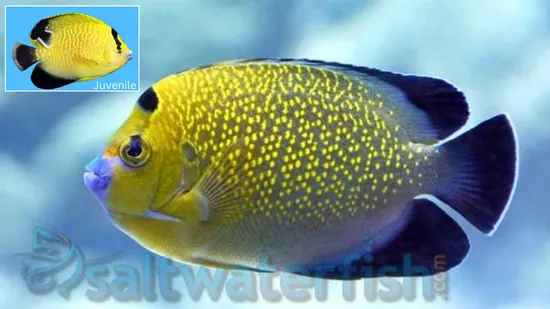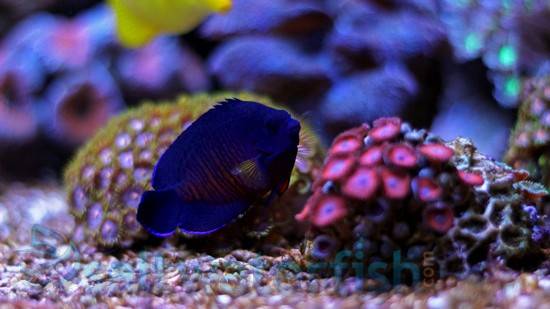Zebra Angelfish
Genicanthus caudovittatus
(2 Reviews)

Zebra Angelfish
Genicanthus caudovittatus
(2 Reviews)
{{ item.name }}
Size: {{ item.extra_field_3 }}
${{ getFormattedPrice(item.saleprice) }} ${{ getFormattedPrice(item.price) }}
To join the waiting list, click here
Free Shipping
With
$199.00
or more in Marine Life.
More details...
Zebra Angelfish Care Facts
| Care Level: | Moderate |
|---|---|
| Temperament: | Semi-Aggressive |
| Diet: | Omnivore |
| Reef Safe: | With Caution |
| Minimum Tank Size: | 125 gallons |
| Max Size: | 8 inches |
The Zebra Angelfish (Genicanthus caudovittatus) offers reef-safe behavior and steady midwater activity that fits well in community marine aquariums. Many aquarists look for a fish that will not nip corals, and this species consistently appears in expert guides as one of the few angelfish considered reliably reef safe. Its planktivorous diet, peaceful temperament, and natural grouping behavior make it a strong fit for hobbyists who want movement in the water column without risking coral damage. Customers often ask how big Zebra Angelfish grow or whether they remain reef safe as adults, and this species answers both concerns with predictable growth and stable feeding habits. With clear sexual dimorphism and bold male striping, it offers visual interest while maintaining compatibility in tanks that include multiple peaceful species. Limited availability means they do not appear in stores often, so securing a healthy specimen when they are in stock is important.
Appearance
The species shows clear sexual dimorphism, with males displaying pale blue bodies marked by multiple vertical stripes and a dark band at the base of the dorsal fin. Females remain light grey or pinkish-grey with a dark band over the eye and a black caudal margin. Both sexes have the characteristic lyre-shaped tail common to the Genicanthus group.
Care & Requirements
Zebra Angelfish thrive in tanks that offer open space for midwater swimming along with rockwork for security. Their natural behavior centers on feeding in the water column, so they do well on diets rich in mysis shrimp, marine plankton, and algae-based frozen blends. A minimum of 125 gallons supports their active swimming style. Stable water quality helps long-term success, especially since this species adapts best to mature reef systems. Multiple small feedings mimic their natural planktivorous habits.
How often should Zebra Angelfish be fed?
Two to three small feedings per day support their planktivorous metabolism.
Do Zebra Angelfish need strong water flow?
Moderate flow is ideal because it keeps planktonic foods suspended.
Can they be kept in newer tanks?
They adapt better to established aquariums with stable parameters.
Tank Mates & Compatibility
This species remains peaceful and fits well with other non-aggressive reef fish. Because males will compete, only one male should be housed in a tank, though multiple females can coexist. Their reef-safe behavior makes them suitable for coral tanks, and they generally ignore sessile invertebrates. Ideal companions include other peaceful midwater species and non-territorial bottom dwellers such as Anthias, Clownfish, Gobies, and Blennies.
Can a Zebra Angelfish be kept with tangs?
Yes, when tangs are peaceful and not overly territorial.
Do they bother shrimp or crabs?
They generally ignore ornamental invertebrates.
Can two males be kept together?
No, males will fight for dominance.
Aquaculture/Availability
Currently, captive-bred specimens are not widely available; most trade relies on wild-caught collection from the Western Indian Ocean. Availability varies throughout the year, and the species does not appear regularly in the aquarium trade.
Are Zebra Angelfish rare in stores?
They appear infrequently due to limited collection regions.
Is captive breeding being attempted?
Captive breeding is not yet common for this species.
Do wild-caught Zebra Angelfish ship well?
They generally ship reliably when sourced and acclimated properly.
FAQ
How large does a Zebra Angelfish get in a home aquarium?
Zebra Angelfish typically reach about 8 inches when fully grown, though growth depends on diet, tank size, and long-term stability. Juveniles grow steadily over the first few years, and a 125-gallon tank helps them reach full adult size without stress.
What should Zebra Angelfish eat on a daily basis?
A balanced routine includes mysis shrimp, marine plankton mixes, and algae-based frozen or prepared foods. Feeding small amounts multiple times per day matches their natural planktivorous feeding style.
Is the Zebra Angelfish fully reef safe with corals?
Yes, this species is widely regarded as reef safe because it feeds on plankton in the water column rather than picking at coral tissue.
How do Zebra Angelfish behave in a community tank?
They stay active in the midwater zone and interact peacefully with a wide range of tank mates. Their harem-based social structure means one male should be kept per aquarium, though several females can be housed together.
What water parameters help maintain their long-term health?
Stable salinity around 1.023 to 1.025, temperature between 72 and 78°F, and pH between 8.1 and 8.4 support strong immune function.
Do Zebra Angelfish require a specific type of aquascape?
They prefer open swimming areas paired with rock structures for retreat. This layout supports natural movement patterns and reduces stress.
How difficult is it to acclimate a Zebra Angelfish?
When added to an established marine system with stable parameters, they acclimate well using standard drip methods.
Can Zebra Angelfish be kept with multiple Genicanthus species?
They can coexist with other peaceful Genicanthus species in large tanks, though males from any Genicanthus species should not be mixed.
I had never purchased fish for my aquarium online before and I was thrilled when the Zebra Angelfish arrived and very healthy.
Reviewed by: Susan Miller on June 2, 2022
Very nice reef fish. Zebra Angelfish cleans detritus in the live rock. Doesn't intrude on the reef. Easy keeper.
Reviewed by: Lia Mamorale on May 2, 2022












